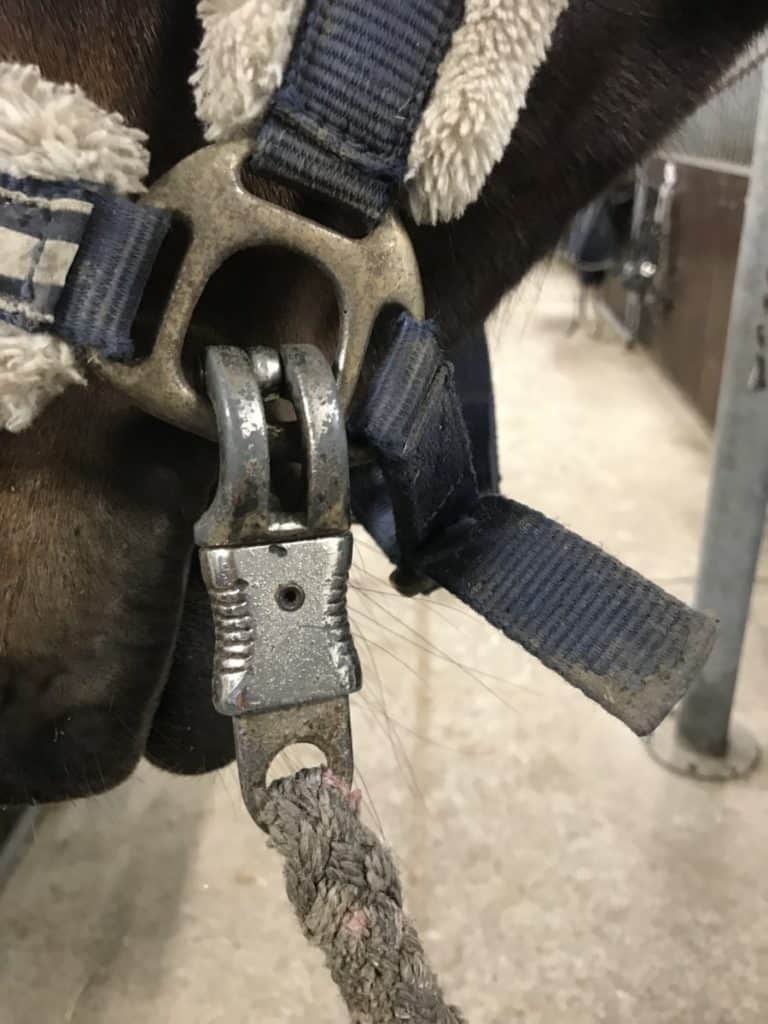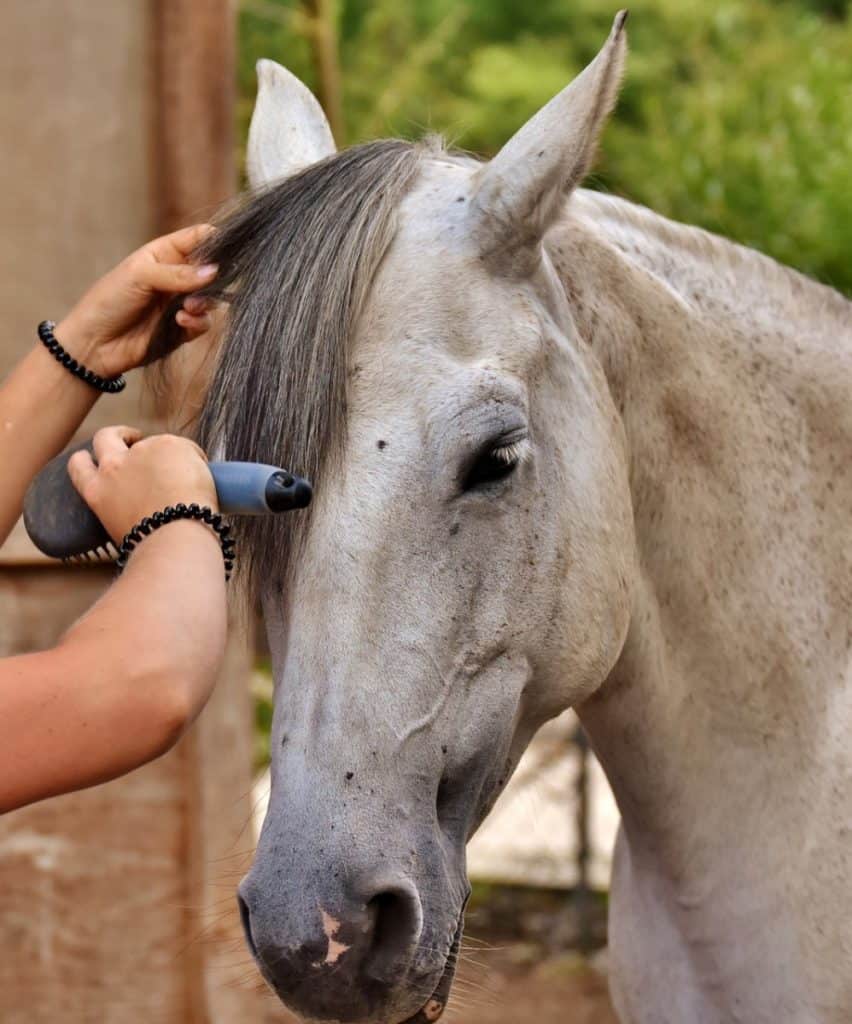
Grooming can seem like a superficial ritual of getting a horse clean before a ride, but in fact, a regular grooming routine is key to keeping a horse healthy. It helps protect the skin, which is a natural barrier for disease, it gets the blood circulation going and gives the groomer an opportunity to check for nicks, bites, and injuries. So whether you are getting ready for a show or just heading out for a quick trail ride, giving your horse a proper grooming is an important part of preparing.
Read on for a full run-down of the why’s, the what’s, the when’s and the how’s of grooming a horse.
Brushes at the ready!
Why Do You Need to Groom a Horse?
Grooming a horse is one of the key maintenance tasks of any equestrian or horse owner and there are many reasons for this.
Improves the condition of the skin and fur coat
Perhaps the most obvious reason for regular grooming is to clean the horse and ensure the fur (and skin) keeps in good condition. A good brush removes dust and dirt so the coat can regain its shine and make the horse look healthy and presentable.
Gets the blood circulation going
Much like when humans get a massage, brushing a horse will stimulate the blood circulation. The blood is what carries oxygen and nutrients to the cells in its body, so grooming consequently helps maintain a strong and healthy muscle mass, reduce swelling and joint pain and can even speed up a recovery process. It also helps keep the fur coat healthy.
Checking for abnormalities
A daily grooming session provides an opportunity to go over the entire horse to check for any nicks, bites or injuries. By doing this every day you will become familiar with the anatomy and unique features of your horse, making it easier to identify abnormalities that may appear over time (or overnight). When grooming the horse, make it a habit to run the hand not holding the brush over the area you are cleaning so you can more easily discover bumps and sores.
Prevention of saddle sores
Whenever dirt gets lodged under the tack it can rub against the horses’ skin and create sores and irritation. This is another reason why it’s so important to groom your horse thoroughly before tacking up. Areas under the saddle and girth are especially vulnerable so make sure you don’t forget to brush under that belly!
Spreads natural skin oils into the fur coat
Grooming helps spread the oils that are naturally produced in the skin and exist in the fur coat. These oils help protect the hair and create that shine we all want.
Interaction and bonding
Grooming is also a time to spend time with and get to know your horse a little better. Try to take a few extra minutes to just ‘hang out’ with your horse and find out something new about his personality, his mood that day, or perhaps where he is ticklish!

We all lead busy lives and many of us have a limited amount of time we can spend at the stables and rush through all the tasks we need to get done. Why not allocate a few extra minutes to your next grooming session? This is often the only one-on-one time you spend with your horse (out of the saddle) and can go a long way in building a stronger bond between the two of you.
How Often Do You Have To Groom a Horse?
A horse should be groomed one time per day and always before and after riding as well as before putting on any tack, blankets or other equipment that might rub against the skin.
After a hard riding session where the horse has been sweating, it is important to either rinse him off or wait until he dries and brush off all the remaining salt as it can easily irritate the skin.
How Long Does It Take to Groom a Horse?
How long it takes to groom a horse really depends on how dirty he is (has he been using the mud puddle for his afternoon nap again?), how long his fur is and the color of the horse (white horses are gorgeous, but getting them clean tend to take longer..). On average, 20 minutes is usually enough time to groom a horse.
What Do You Need to Groom a Horse?
We like to keep it pretty simple when it comes to grooming. Find the tools you like that work for your horse and stick to that. The most important is to keep the brushes clean and don’t use them on other horses as this can transfer infections and diseases. Therefore, each horse should have its own set of brushes (rather than each rider).
The below list has everything you need for grooming. There are also a few optional items that you may or may not need depending on your horses’ coat, his specific needs as well as the environment, he is in.
- 1 rubber curry comb (we prefer rubber to metal or plastic)
- 1 firm brush
- 1 soft brush
- 1 face brush
- 1 hoof pick
- 2 sponges
- 1 soft cloth
- 1 mane and tail brush
- 1 shedding blade (we highly recommend SleekEZ)
- 1 detangler & shine spray (optional)
- 1 lanolin-based hoof oil/ointment (optional)
- 1 fly spray (optional)
- 1 brush tote/caddy/bucket
Brushes come with either natural or synthetic bristles. We haven’t tried these ones personally, but we love Equirex’ sustainability ethos for horse and rider apparel – we need more focus on these issues in the equestrian world! If that’s up your alley, why not check out these brushes created from sustainably sourced German wood and bristles made of plant fibers?
If you want to know what we use and recommend for grooming, check out our recommended grooming products here.
How Do You Properly Groom a Horse?
1. Prepare your grooming kit
Get your grooming kit with clean brushes ready in a practical place close to where you will tie your horse up, but not so close that either of you can trip over them. If possible, place them somewhere where you won’t have to walk behind the horse or under the ropes you have tied him up with to get to them.
2. Securely attach the horse
Put a halter on the horse and attach him in cross-ties or secure him with a quick-release knot to a solid pole, steel bar or similar. If you don’t know how to tie a quick-release knot, this video provides a great demo.
3. Clean out the hooves
The horse’s feet are the most prone to injury, so it makes sense to clean and check them first in case there are any issues that would prevent you from riding or require you to call a veterinarian or farrier for a consultation.
This is also the trickiest part of the grooming process and can be a bit intimidating, especially for a beginner. A horse’s hooves are quite heavy and while many horses will help hold the weight of their foot while you are holding it others may not be as well-mannered and like to lean on you. It takes a few tries to get the technique down and figure out how the horse behaves during this process, so let’s have a look at it step-by-step.
How to lift a horse hoof
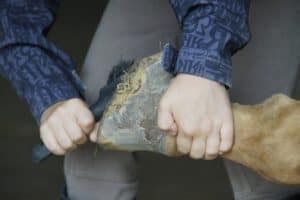
Start with one of the front legs. Stand next to the horse’s leg with your back to the horse’s head, looking towards his bum. Slide your hand down from the shoulder along the back of the leg using light pressure all the way to the ankle, lean slightly towards the body of the horse and when you reach the ankle say ‘up’ or ‘hoof’ and lift the leg upwards and towards you until the leg is in about a 90-degree angle at the knee.
Hold the leg just above the hoof with the hand closest to the horse and use the other one to hold the hoof pick. Alternatively, you can place the hoof between your knees, so you are supporting the weight more with your legs and have both hands free. This can be a better solution for people that struggle with back pain. Regardless of the technique you use, always be aware of your posture – keep a slight bend in your knees and hold your back straight to avoid straining your lower back.
When lifting the hind legs, the technique is the same, however, pull the leg out slightly backward before resting it in your hand or between your knees. Usually, we will quickly find a ‘balancing point’ where the horse is most comfortable, and this tends to vary from horse to horse.
When you are done picking the hoof clean, gently put it down on the ground. Sometimes, beginners simply let go of the hoof expecting the horse to put it back down themselves, however, if the horse is relaxing and is not prepared, the hoof could end up dropping straight to the ground, which could damage the hoof and be uncomfortable for the horse if he is standing on a hard surface.
How to pick a horse hoof
Dig out the dirt in the hoof starting from the triangle-shaped frog and pick towards the shoe or edge of the hoof. Repeat until the hoof is clean.
Tip: Be gentle when cleaning inside and around the frog as it is quite sensitive.
Check the hoof health

Just like the rest of the grooming process, picking the hooves is an opportunity to check for any health issues or injuries. When you pick the hooves of a horse, notice if there is a strong smell, if the frog seems porous or has changed to a darker color. All these signs can be indicative of thrush, which is an infection quite common in horses, but if left untreated can spread and eventually cause lameness.
Another common problem to look for is greasy heel (or mud fever), which commonly affects horses that stand in rain and mud over longer periods of time. A horse with a greasy heel will have inflamed or cracked skin on its heel(s). Similarly, to thrush, the greasy heel can lead to lameness if left untreated.
Finally, have a look at the general condition of the hoof inside and out. Are the horseshoes still properly attached? If the hooves are particularly dry or cracked, you may want to start applying a hoof oil or ointment once or twice a week as part of your grooming routine.
4. Curry the horse
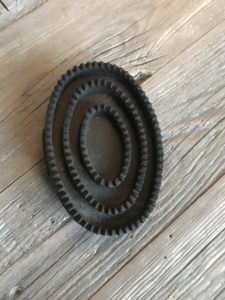
Moving on to the body of the horse, start by using a rubber curry comb (we prefer rubber as metal can be a bit harsh and plastic is, well, plastic) in circular motions to bring dirt and dust to the surface. How much pressure you need to apply will depend on the thickness of the fur coat. Avoid bony areas such as the legs, spine, and face as these are more delicate. Clean the brush between strokes by lightly tapping it against a wall, just be careful not to frighten the horse when doing so.
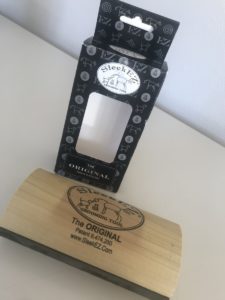
Shedding tip: if your horse sheds a lot in the spring, we highly recommend the SleekEZ. It has a blade with smaller teeth than a regular shedding blade that grabs the hair at a deeper level and it comes off so easily! If you want to see it in action, check out this video.
5. Brush the horse with a hard brush
After you finish currying, follow up with a firm brush to brush off all the dust that is now laying on the surface of the fur. Use flicking strokes to lift it off more easily and go over the same areas as you curried. Clean the dust off your brush ever so often by running it over a shedding blade (or another tool you have handy).
6. Brush the horse with a soft brush
Then go over with a softer brush to remove the fine dust and magically unveil that healthy, shiny coat! You can use this brush on the entire horse.
7. Groom the mane and tail
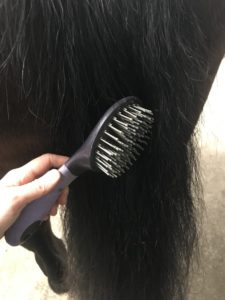
Depending on the fullness of your horses’ mane and tail you may want to apply some detangler before combing through them. If there are large knots, try to comb through these with your fingers before using a brush to avoid too much breakage.
Start at the bottom and work your way up and hold on to the section you are brushing above the comb to avoid tugging. To round it off, clean under and around the top of the tail with a damp sponge.
Safety tip: always make sure you stand to the side when brushing the tail in case the horse suddenly kicks back.
8. Clean the face of the horse
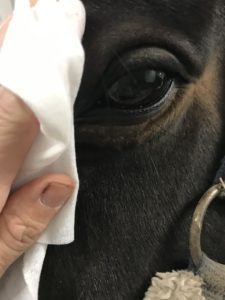
You can absolutely use a soft brush for the face; however, we prefer a smaller brush for this to get into all those nooks and crannies. After brushing off the dust, you can use a damp sponge or cloth to carefully clean around the eyes and nostrils. Make sure you don’t use the same sponge in the face as you use for the tail to avoid spreading any nasty bacteria to the eyes.
9. Apply fly spray (optional)
If you live in an area where flies and insects are an issue, using a fly spray will likely make your horse more comfortable. We recommend opting for a spray with natural ingredients and avoid the face. If you want to protect the face specifically, you can read more about our recommended fly mask here.
How Do I Make My Horse Shiny?
Have you groomed and groomed, the horse is clean as can be, but the coat is just refusing to give you the shine you want? Maybe you are getting ready for a competition or show and want that extra touch of glam? Here is where a good shine spray comes in. There are many on the market to choose from and they all pretty much do the same job. Personally we use the Showsheen from Absorbine which works great!
Horse Grooming Basics

When grooming a horse, there are a few basic rules of thumb we like to follow.
- Always brush the horse as you would stroke it – in the direction of the hairs. Stroking or brushing against the hairs will feel uncomfortable and may irritate the horse.
- When grooming, start at the front and top and work your way towards the back and bottom.
- Pay attention to the horse’s body language as you brush him and look for signs of irritation or discomfort. Most horses will have a favorite itchy spot, a least favorite or sensitive spot and some will also have a ticklish spot.
Reading these signals is particularly important if you don’t already know the horse. When you find the itchy spot, you will notice the upper lip of the horse lengthen and ‘wiggle’. This means he is enjoying being scratched and he may try to reciprocate by scratching you back. If he does, be aware that horses also use their teeth to scratch each other so it might be better to calmly but firmly push his face away from you.
Be gentle when brushing the face and under the belly. Some horses dislike being brushed or even touched in the face and others are very sensitive under their bellies.
- Put some force into the brush strokes. If the horse has a thick coat, it takes a bit of effort to get the dust to the surface and then brush it off.
Staying Safe When Grooming a Horse
As always, when handling and being around horses, there are a few safety ground rules we should all follow, and grooming is no exception. It is easy to get complacent when we know a horse well (we are guilty of this too!), but remember that safety rules are there for those rare occasions that are impossible to predict and that’s why it is so important to incorporate these safety precautions into our daily routines and let them become second-nature.
- Always have the horse securely attached in crossties or with a lead rope to a solid pole or bar using a quick-release knot.
- Don’t place your grooming kit too close to the horse where he, you or others in the barn can knock it over or stumble over it.
- Always approach the horse from the front or side and use your voice to let the horse know where you are. We have a whole article explaining the best ways to approach a horse if you are not sure how to do that.
- Be attentive when passing behind the horse or under its head. Use your hands to signal where you are moving (such as a hand on his rump before you pass behind him) and your voice to let him know where you are.
- Pay attention to the horse’s body language. Very often, changes in body language will give you valuable information about his mood and provide an early warning about any mischief he may be planning. Intense whisking of the tail, stomping of the feet, ears pressed flat backward are all usually signs of irritation and a cue for you to look for things that may be bothering him (and potentially move away until you do).
How to Clean Your Brushes
Soak the brush bristles in water with a non-toxic soap or detergent and whisk them around to loosen the dirt and grime. Rinse and repeat until the water no longer gets discolored when you soak them. Make sure to rinse thoroughly before you use them on a horse as soap residue can irritate a horses’ skin. We encourage the use of natural cleaning agents whenever possible.
There are many different ways to groom a horse and this guide will be a solid starting point if you are a beginner. After a while, you will find your own routine, tools, and techniques that work best for you and your horse.
This article is accurate and true to the best of the author’s knowledge. It is not meant to substitute diagnosis, prognosis, treatment or any type of medical advice for humans or horses. Animals exhibiting signs and symptoms of distress should be seen by a veterinarian immediately.

